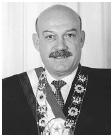PARAGUAY
Luis González Macchi
President

(pronounced "loo-EES gohn-ZAH-lace MAH-kee")
"We must seize this great opportunity to change the destiny of this country."
In the heart of South America lies the small Republic of Paraguay. This landlocked country is bordered by Bolivia on the north and northwest, by Brazil on the east, and by Argentina on the south and west. It has an area of 406,752 sq km (157,048 sq mi). The Paraguay River divides the country into two regions. The eastern region is the highlands area where 90% of the country's 5.9 million (July 2002 estimate) people live. It contains the densely forested Paraná Plateau, rolling foothills, marshes, and grasslands. The western region, known as the Chaco Boreal, is a vast, flat plain with rough grasses, cacti, and thorny shrubs. Meteorological extremes of drought and flooding have discouraged settlement and agricultural development in the western region. The Paraná River defines the country's southeastern boundary and provides the only outlet to the sea. Asunción is Paraguay's capital and largest city, with a population of over 1,400,000.
Most Paraguayans (95%) are mestizos (people of mixed Spanish and Guaraní Indian ancestry). Most of the remaining population is Guaraní, native settlers in the region. Spanish and Guaraní are both official languages, with government publications produced in both languages. Almost all Paraguayans are Roman Catholic (90%), although there are small pockets of Mennonites and other Protestant denominations. Life expectancy is high—72 years for males and 77 years for females. The literacy rate is about 92%.
Paraguay's market economy, once dominated by agriculture, forestry, and fishing, is now largely service oriented. Soybeans are the largest export crops, followed by cotton, meat, and timber. There is also a large informal sector of street vendors and those engaged in the reexport of imported consumer goods such as electronic equipment, office products, liquor, perfume, and tobacco products. Paraguay is a member of Mercosur (Southern Cone Common Market). Brazil is Paraguay's most important trading partner, accounting for about one-third of all trade. Argentina is a distant second.
In the late 1970s and early 1980s, construction of the world's largest hydroelectric dam, the Itaipú, on the Paraná River brought Paraguay the highest economic growth rate in Latin America. As of early 2000, however, Paraguay's economy was in recession following the devaluation of the Brazilian currency and a virtual halt in trading activity. Adversely affected was the Itaipú hydro complex (located in Paraguay, one of the world's largest hydroelectric projects), of which Brazil is part owner. The Itaipú plant supplies 20% of Brazil's electricity.
The country's banking sector collapsed in 1998 due to corruption and mismanagement, causing thousands of Paraguayans to lose their life savings. The unit of currency is the guaraní .
ADDRESS
Oficina del Presidente
Palacio de Gobierno
Asunción, Paraguay
Comment about this article, ask questions, or add new information about this topic: